Results 1-13 of 13
<<< Previous 1 Next >>>
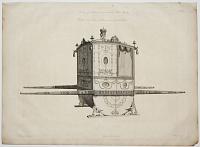
Design of a Sedan Chair as executed for Her Majesty. Dessein d’une Chaise à Porteur executée pour la Reine. Plate VI.
R. Adam Architect 1771. P. Begbie sculp.
Published as the Act directs 1773.
Engraving with small margins. Plate 444 x 591mm. 17½ x 23¼".
Design for a sedan chair; Volume I, part 5, "Works in Architecture". Robert and his brother James Adam forever changed the face of British architecture by introducing innovative Classical design ideas. From 1754-57, Robert lived in Italy where he had a long productive friendship with Piranesi, which was inspirational for both men. Upon his return, the brothers launched their career by building the Adelphi from the Thames to the Strand in London, which although not a commercial success at the time, included one of London's most cherished buildings, the Adlephi Theatre. Together, the Adam brothers designed and built some of the most famous buildings in England, including such bastions of English architecture as Kenwood House, Keddlestone Manor, and Syon House. To the interiors of their English country houses, the Adams brought wonderful ornamental elements in niches, lunettes, festoons and reliefs. Their classically designed buildings were so numerous in London that they changed the prevailing feel of the city and established their brand of neo-Classicism as the model of elegance and importance. It is asserted that the brothers originated the concept of the uniform facade attached to the typical English row house, an architectural device that distinguishes London buildings. This monumental contribution is evidenced in the Adams' designs for Portland Place and Fitzroy Square, and these were used as architectural models for the whole city. The brothers brought their talents into other areas by designing furniture to complement their beautiful interiors and by creating and publishing a treatise of design entitled 'Works in Architecture'. The work was published in three volumes over an extended span of time, beginning in 1773, with the final volume being published posthumously in 1822.
[Ref: 27736] £350.00
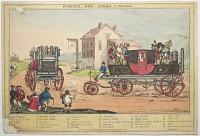
Gurney's New Steam Carriage.
[Drawn by an A]mateur.
Pub Dec 12 1827 by J. Fairburn Broadway Ludgate Hill.
Etching with fine hand colour. Sheet 255 x 375mm (10 x 14¾"). Trimmed within plate, bottom left corner lacking, affecting signature and key, hole in border and sky top left. Extremely scarce but damaged.
An image of two of Sir Goldsworthy Gurney's carriages, showing the profile and rear, with a 30-point key naming the main components. The onlookers are caricatured yokels. The Gurney Steam Carriage Company of Regent’s Park was the first commercial steam-carriage company to go into operation, in 1827. They stopped building steam carriages in 1832 because of the competition from railways. Not in BM.
[Ref: 59498] £480.00

D.r Church's London and Birmingham Steam Coach, Built at Birmingham, 1833.
John Cooke, Delin. Eng.d by Josiah Allen birm.m.
Published by Josiah Allen, Birmingham, & by Mess.rs Ackermann, Tilt & Fullers, London.
Fine & scarce steel engraving. Sheet 210 x 295mm (8¼ x 11½"). Trimmed within plate, affecting publication line.
A three-wheeled steam coach carrying passengers down a country road. There is no sign of a flue. Dr. William Church (c.1778-1863), an American inventor, patented two steam carriages, the first in 1832, which wasn't built, and a second in 1835, after which he founded the London and Birmingham Steam Carriage Company. Whether the London to Birmingham run was ever completed is uncertain, but soon Church turned his attention to designing locomotives.
[Ref: 62118] £450.00

Pedestrian Hobbyhorse. Exhibiting at 40, Brewer Street, Golden Square. M.r Johnson, Patentee, 75, Long Acre.
Pub.d by R. Ackermann, 101 Strand. Feb.y 1819.
Aquatint with very fine colour. Sheet 135 x 180mm (5¼ x 7"). Trimmed around image, laid on album paper.
A 'dandy horse', a primative bicycle on which the rider proceeded by pushing forward on the ground. Originally patented in 1818 in Germany by Baron Karl Drais, this is the ‘pedestrian curricle' of Denis Johnson (c.1760-1833), a coachbuilder of Long Acre who made at least 320 during the short craze for velocipedes in 1819. Like many crazes it was killed by a health warning. A variation of the print published in Ackermann's Repository of Arts
[Ref: 59404] £260.00
(£312.00 incl.VAT)
![[Man riding a penny farthing.]](img-thumbnail/jpegs/8925.jpg)
[Man riding a penny farthing.]
Frank Allport [signed in ink lower left.]
[n.d., c.1880.]
Pen and ink and watercolour, sheet 255 x 205mm. 10 x 8".
An original caricature sketch of a man with a demonic beard, moustache and extraordinarily shaped hair with pony tail riding a penny farthing bicycle. The ordinary, high wheel or penny-farthing was the first true bicycle with which actual speed and distance could be achieved in a practical manner. Based on the original French Boneshaker, James Starley and others produced bicycles with front wheels of ever increasing size, starting about 1870.
[Ref: 8925] £320.00
![[Sedan chair and horse fall into water]](img-thumbnail/jpegs/44224.jpg)
[Sedan chair and horse fall into water]
[Anon., c.1800]
Etching, unique & rare; sheet 340 x 290mm (13½ x 11½"). Trimmed; tears to edges; glued to backing sheet; another impression of same plate verso of same plate.
[Ref: 44224] £260.00
(£312.00 incl.VAT)

The Motor Car. Words by Richard Morton, Adapted to the Meolody of ''Funiculi Funicula'' by L. Denza. Sung with Great Success by John F. Sheridan.
Ricordi's Copyright 1897.
Pamphlet; pp. (8), cover with chromolithographic portrait. 350 x 255mm (13¾ x 10"). Cover detatched, some soiling.
The words and music of a comic song about an attempt to drive a motor car from Camberwell to Brighton, ending with the car exploding. The cover depicts John Francis Sheridan (1843-1908), an Irish-American comic actor, dressed as a Chinaman, carrying a pole with two scenes from the song. He ended his career in Australia, dying in a hotel in Newcastle. Very rare & early Motor Car item, Brighton interest.
[Ref: 58854] £490.00

Schlitten=fahrt auf der Elbe. 36
Kliedertracht u. Gebrauche in Hamburg.
Fine coloured aquatint; Sheet 175 x 265mm (6¾ x 10½"). Trimmed to image, small tear top right.
'A Sleigh-Ride on the Elbe'. A horse-drawn sleigh driven by a man seated on the back, a woman passenger under a leopard-skin, the outline of Hamburg in the background.
[Ref: 37989] £80.00
(£96.00 incl.VAT)

The New Steam Carriage... It has been constructed by Mr Goldsworthy Gurney, the Inventor and Patentee.
G. Morton Del.t. Pyall Sculp.t.
Published by Thos. Mc.Lean, 26 Haymarket.London. [n.d., c.1828.]
Coloured aquatint. 300 x 440mm (12 x 17¼"). Time staining at edges, very slight central crease.
A large steam-driven coach passing an ale-house on the London to Bath road, with passengers including a kilted soldier. In the background are amazed spectators and a windmill. In July 1829 a steam coach built by Sir Goldsworthy Gurney (1793-1875) ran from London to Bath and back at an average speed of 14mph, double that of a horse-draen coach. However the introduction of heavy tolls for his vehicles and Gurney was bankrupted with debts of £232,000.
[Ref: 49010] £680.00

The New Steam Carriage!!
[n.d., c.1828.]
Coloured aquatint, scarce. Printed border 115 x 215mm (4½ x 8½"). Trimmed, title excised and replaced, laid on album paper.
A large steam-driven road vehicle, with a driver and eight passengers, overtaking a horse-drawn coach. A scene with a similar carriage, but with an ale house looming large, was engraved by Pyall after G. Morton and published by McLean c.1828.
[Ref: 44561] £390.00
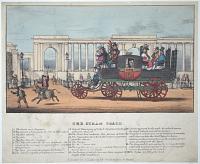
The Steam Coach.
[G. Davis.]
Published by J. Didsbury 22 Southampton St. Strand. [n.d., c.1820.]
Extremely scarce lithograph, with hand colour. Sheet size: 235 x 285mm (9¼ x 11¼"). Diagonal crease and small stains.
Goldsworthy Gurney’s Steam Carriage passing the gates of Hyde Park, with passengers onboard including a mother and child peeping out through the window of the carriage in the centre, and a boy playing a trumpet towards the front. There are four chimneys at the rear of the coach. Passers by, including one figure on a donkey, can be seen looking at the coach.
[Ref: 52100] £480.00
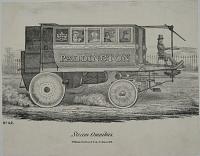
Steam Omnibus.
J. R. Barfoot.
William Darton & Son, Holborn Hill. [n.d., c.1840.]
Lithograph, sheet 170 x 215mm. 6¾ x 8½". Sheet trimmed, laid onto album page.
A steam omnibus operating on the Paddington to City of London service. Despite the introduction of the first steam omnibus in 1833, horse-drawn buses, first introduced in London in 1829, remained more common and survived until 1912 when they were superseded by the new motorised omnibuses. Numbered 'No.42' lower left.
[Ref: 14856] £110.00
(£132.00 incl.VAT)
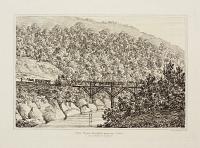
The Tram Bridge over the Tawe.
Drawn & Etched by I.G. Wood.
London Published by Ino. Geo. Wood. 1817.
Soft ground etching. Plate: 180 x 250mm (7 x 9¾"), with large margins.
A view of the horsetram bridge built over the river Tawe in Wales. The horse tram was started in Britain on the Swansea and Mumbles railway and used specifically for tramlines and carriages to transport goods and people.
[Ref: 46302] £50.00
(£60.00 incl.VAT)
<<< Previous 1 Next >>>




![[Man riding a penny farthing.]](img-thumbnail/jpegs/8925.jpg)
![[Sedan chair and horse fall into water]](img-thumbnail/jpegs/44224.jpg)






